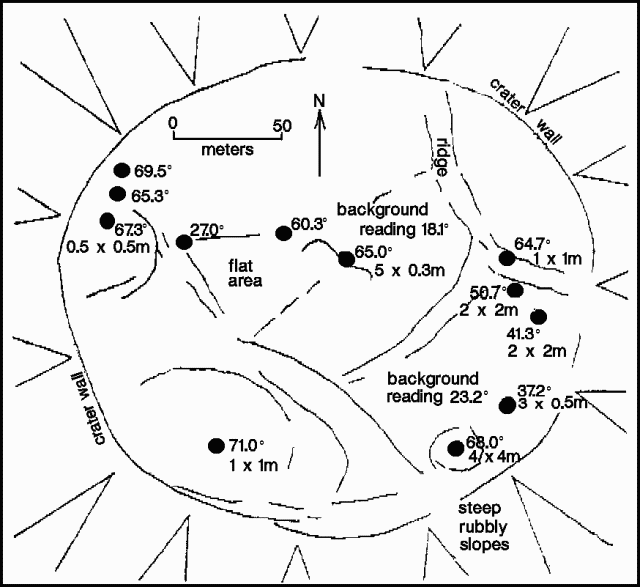Report on Reventador (Ecuador) — September 1990
Bulletin of the Global Volcanism Network, vol. 15, no. 9 (September 1990)
Managing Editor: Lindsay McClelland.
Reventador (Ecuador) Low-temperature fumarolic activity
Please cite this report as:
Global Volcanism Program, 1990. Report on Reventador (Ecuador) (McClelland, L., ed.). Bulletin of the Global Volcanism Network, 15:9. Smithsonian Institution. https://doi.org/10.5479/si.GVP.BGVN199009-352010
Reventador
Ecuador
0.077°S, 77.656°W; summit elev. 3562 m
All times are local (unless otherwise noted)
Abundant small fumaroles were observed 17-19 August, within the crater and in concentric cracks near the rim. These fumaroles emitted little gas and were fairly quiet. Fumarole temperatures, measured using infrared thermometry, reached 71.0°C (figure 1).
 |
Figure 1. Sketch map of the crater of Reventador showing fumarole locations (solid circles), sizes, and temperatures, August 1990. Courtesy of Sean Hodges. |
Geological Summary. Volcán El Reventador is the most frequently active of a chain of Ecuadorian volcanoes in the Cordillera Real, well east of the principal volcanic axis. The forested, dominantly andesitic stratovolcano has 4-km-wide avalanche scarp open to the E formed by edifice collapse. A young, unvegetated, cone rises from the amphitheater floor to a height comparable to the rim. It has been the source of numerous lava flows as well as explosive eruptions visible from Quito, about 90 km ESE. Frequent lahars in this region of heavy rainfall have left extensive deposits on the scarp slope. The largest recorded eruption took place in 2002, producing a 17-km-high eruption column, pyroclastic flows that traveled up to 8 km, and lava flows from summit and flank vents.
Information Contacts: S. Hodges, Univ of Oxford. The Oxford field team also included J. Bass, S. Crampton, J. Dinares, S. Hart, R. Hartley, C. Mandeville, M. More, K. Ogden, J. Scarrow, and A. Whittingham.

